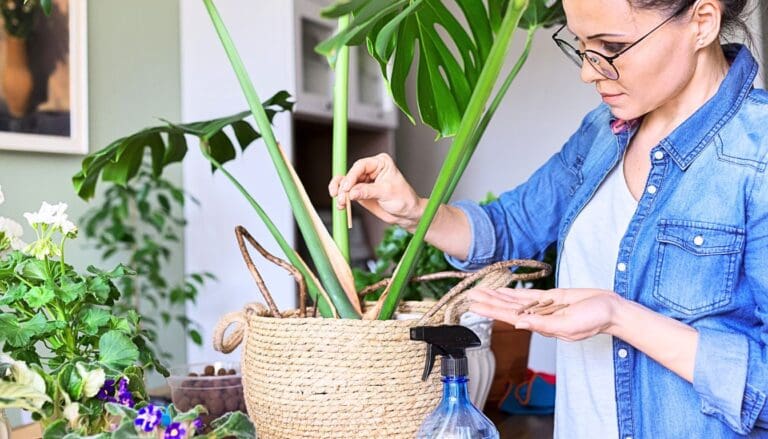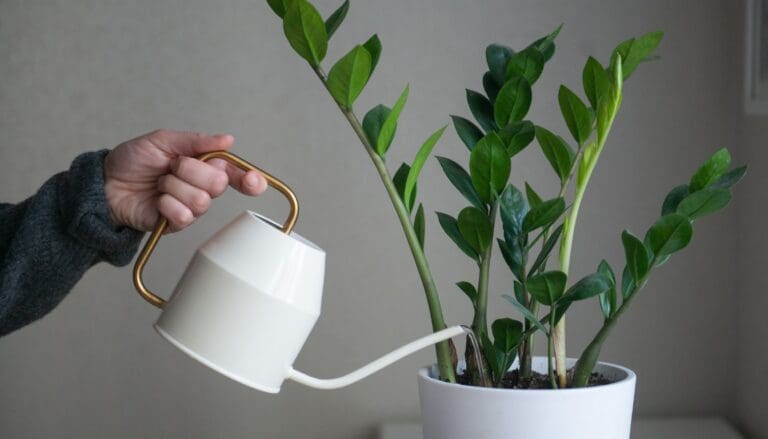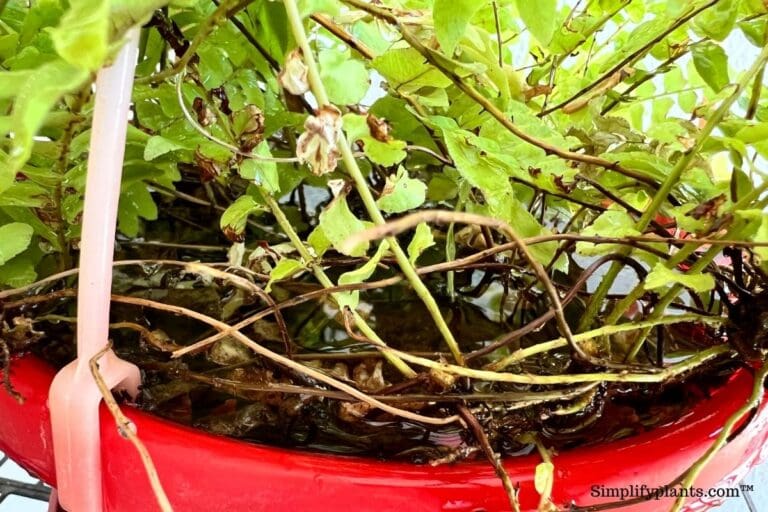Do Calathes Go Dormant In Winter? (+How To Care)
Most tropical plants go dormant in winter, and Calathea also reduces or stops growing once the mercury level drops. But do Calathes go dormant in winter? How should we deal with the same? Let’s find out.
In general, Calathea goes dormant during the winter season as the living environment doesn’t favor new growth. The low temperatures and insufficient sunlight are not ideal for new growth in calathea, so the plant goes dormant or slows down its growth to save energy for the following growing season.
There is a drastic change in humidity, temperature, availability of light, and other essential factors during the winter season.
So, the care routine of calathea needs to be adjusted to keep them healthy and thriving.
You must reduce watering and stop fertilizing your Calathea during winter.
The humidity and temperatures go low during winter, so you must protect the Calathea by controlling the temperatures and keeping it warm. You must not let the humidity drop below 50%.
You need to understand several more factors to care for your Calathea during the dormant season, and I have included all that in this article. So, make sure you stick till the end.

Please note: Simplify Plants is reader-supported. Some links in the post are affiliate links and I get a commission from purchases made through links in the post.
Do Calatheas die in winter?
Calathea will not die in winter if you can provide the proper care, but if you overwater it or overfertilize it, your Calathea can die in winter.
The conditions remain unfavorable for your Calathea during winter. The temperatures get low, the humidity falls, and the duration and intensity of the sunlight reduce.
These conditions are opposite of what Calathea prefers, so if you don’t provide enough care during this time, the plant will develop problems or diseases and might die because of those.
Do calathea plants go dormant?
Yes, Calathea goes dormant in winter, which is natural and not something to worry about.
Calathea doesn’t prefer the winter season, so it stops growing and conserves its energy. It starts using the saved energy once the growing season approaches.
However, you should help your Calathea survive and get through the dormant season by changing the care routine.
How cold is too cold for calathea?

Calathea is a tropical plant, so naturally, it prefers a warm climate. The ideal temperatures for your Calathea will be between 65-80°F.
If the temperatures drop below 55°F, it will become too cold for your Calathea. So, it would help if you never exposed it to such low temperatures.
Placing the Calathea outside during the winter can expose it to low temperatures, frost, and cold drafts. So, you must beware of this and keep the plant inside the house.
Also read: What Temperature Can Calathea Tolerate? (Ideal Temperature Range)
How to help Calathea survive the dormant season?
You can help your Calathea plant survive the winter season with enough care and attention. But the care needs to be different from other seasons.
You can’t care for your Calathea in the winter like you would during the other seasons. If you give it the same amount of water and fertilizer, you’ll end up killing it.
So, let’s see how to care for your Calathea the right way in winter.
1. Use artificial lights in winter.

During winter, the intensity of sunlight reduces, due to which your Calathea doesn’t get sufficient light. Along with that, the duration of sunlight also reduces in winter.
All these call for more light. Although Calathea doesn’t require a lot of light in winter because it goes dormant, it would still require some light to remain healthy.
Since you can’t get enough natural light in winter, you should opt for artificial light, called grow lights. Calathea will require light at 10,000 lux.
However, use artificial lights for not more than 16 hours as Calathea will require 8 hours of darkness.
Also read: How Much Light Do Calathea Plants Need? (Calathea Plant Light Requirements)
2. Stop fertilizing your Calathea in winter.
Calathea is a sensitive plant that can get overfertilized easily. It requires little fertilizer during the growing season.
And if you continue that, even during winter, the plant can die due to the fertilizer.
Since Calathea goes dormant during winter, it starts conserving its energy. The plant stops growing, so the fertilizer doesn’t get used.
The excess fertilizer stores up in the soil and goes into the roots, burning them. If you don’t want to damage the roots of your Calathea plant, don’t fertilize it during winter.
Start reducing the fertilization before winter arrives, and once winter arrives, stop it entirely.
Also read: Should I Fertilize Calathea? (How Often+Best Fertilizer)
3. Reduce watering your Calathea during winter.

In the growing season, Calathea requires enough water to keep the soil moist, but the soil takes time to dry during winter.
During winter, the sunlight reduces, which keeps the soil moist longer than usual. So, naturally, you will need to water your Calathea less during winter.
You can reduce the watering slightly during winter and only water after checking the soil. If the top inches are dry, you can water your Calathea.
When I say watering, I mean both frequency and amount of water.
Also read: How Often To Water Calathea? (A Complete Calathea Watering Guide)
4. Water your Calathea with room-temperature water.
During winter, the water might become cold or even start freezing. Your Calathea will be shocked to death if you water it with this water.
So, you must switch to room-temperature or tepid water always when you water your Calathea in winter.
Using cold water on your Calathea is a big no if you want it to survive the dormant period.
5. Keep your Calathea inside during winter.
Many people like to take their houseplants outside and keep them on the balcony or patio. It is fine as long as the plant is not getting direct sunlight or other unfavorable conditions.
However, it would be best not to take your Calathea outside during winter as the temperatures remain low, and the plant can also get exposed to frost and cold drafts.
You must protect your Calathea during winter, so it is better to keep it inside the controlled environment of your house.
Also read: Where To Place Calathea Plant? (Factors To Consider+Ideal Placement)
6. Provide enough humidity to your Calathea.

Calathea loves moisture. High humidity allows Calathea to thrive and remain healthy as well.
The humidity reduces significantly during winter, and you can use a humidifier to make sure the humidity remains high for your Calathea.
You can use other humidifier alternatives, such as a pebble tray or misting the plant. You can even move the Calathea to the bathroom if it gets all other conditions adequately there.
You can also group your Calathea with other moisture-loving plants.
7. Watch out for spider mites!
Spider mites are the enemy of Calathea plants, and these are the most common among all the pests that attack your Calathea.
Spider mites prefer dry conditions, and winter allows them to attack Calathea by reducing the temperatures and the humidity.
To keep the spider mites away, you must stay prepared and spray a neem oil solution on your Calathea. You must not create dry conditions that are suitable for spider mites.
You must provide sufficient humidity and water and not let the soil go entirely dry.
8. Don’t repot your Calathea in winter, unless necessary!

Calathea is sensitive to repotting, and it has delicate roots that don’t prefer changes. Calathea requires repotting only if it gets rootbound.
You must not disturb the roots otherwise, especially during the winter season.
Winter comes with unfavorable conditions that force the plant to grow dormant, and repotting also causes stress to your Calathea. The plant might not be able to withstand both conditions together.
So, you must not repot your Calathea when it is dormant and wait for the growing season unless you notice any problematic situation like root rot.
Also read: Do Calathea Like To Be Root Bound? (+When To Repot)
9. Keep your Calathea clean in winter.
You should keep your Calathea clean in all seasons, especially during winter, as this is when the plant receives less sunlight.
Less sunlight means less photosynthesis. On top of that, if the leaves are dusty, the photosynthesis rate will be even lower than natural.
This can become a problem as the plant will become weak due to a lack of photosynthesis which means a lack of energy.
If you mist your Calathea to increase the humidity, you can wipe the leaves to keep them dust-free.
10. Find the ideal spot for your Calathea inside the house.

Since Calathea requires a different care routine in winter, its current location might not suit the plant.
You must remember these points while placing the Calathea to help it survive dormancy.
- Place your Calathea away from windows with cold drafts.
- Keep the Calathea away from frequently opened and closed windows and doors.
- Place your Calathea away from the direct air of the AC.
- Don’t keep your Calathea too close to the fireplace, furnace, or any other heat source.
- Don’t place your Calathea on the balcony or any space outside the house.
- Place your Calathea in a brighter location where it will get a good amount of sunlight.
Final words
Many houseplants go dormant in the winter season, including Calathea, as this is not the season that provides the ideal growing conditions to these plants. Therefore, these plants require a different care routine in winter.
You must stop fertilizing, reduce watering, provide enough light, and keep your Calathea safe from the low temperatures and dry drafts of winter. Avoid caring for it as you would do during the growing seasons.
With the correct knowledge, you can take care of your Calathea when it goes dormant and helps it get through the dormant period.
Source: NCBI, University of Florida, Wikipedia, Growing Indoor Plants with Success, Agriculture, and Natural Resources, University of California, Missouri Botanical Garden.
Recommended Garden Supplies
| Product Image | Our Recommended Gardening Supplies | Check Offers! |
|---|---|---|
Top Top
Top
Top
Top
Top
Top
Top
Top | rePotme Houseplant and Tropical Classic Potting Soil Mix | Check Offer On Amazon |
 Top
Top
Top
Top
Top
Top
Top
Top | Espoma Organic Indoor Plant Food | Check Offer On Amazon |
 Top
Top
Top
Top
Top
Top
Top
Top | GooingTop LED Grow Light 6000K Full Spectrum Clip Plant Growing Lamp | Check Offer On Amazon |
 Top
Top
Top
Top
Top
Top
Top
Top | Soil Moisture Meter | Check Offer On Amazon |
 Top
Top
Top
Top
Top
Top
Top
Top | Govee Hygrometer Thermometer, Bluetooth Enabled! | Check Offer On Amazon |
 Top
Top | LEVOIT Humidifiers for Large Room(Best For Plants) | Check Offer On Amazon |
 Top
Top
Top
Top
Top
Top
Top
Top | Upgraded DIY Automatic Drip Irrigation Kit, 15 Potted Houseplants Support | Check Offer On Amazon |
 Top
Top
Top
Top
Top
Top
Top
Top | Stainless Steel Heavy Duty Gardening Tool Set | Check Offer On Amazon |
 Top
Top
Top
Top
Top
Top
Top
Top | Bonide Insecticidal Soap | Check Offer On Amazon |
 Top
Top
Top
Top
Top
Top
Top
Top | Bonide 32 oz Spray Neem Oil for Organic Gardening | Check Offer On Amazon |
 Top
Top
Top
Top
Top
Top
Top
Top | Garden Safe Fungicide | Check Offer On Amazon |






